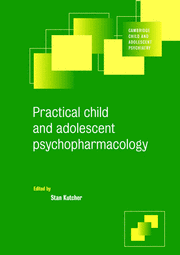Book contents
- Frontmatter
- Contents
- List of contributors
- Preface and acknowledgements
- 1 Child and adolescent psychopharmacology at the turn of the millennium
- 2 Developmental psychopharmacology
- 3 Clinical aspects of child and adolescent psychopharmacology
- 4 Depression
- 5 Bipolar mood disorders: diagnosis, etiology, and treatment
- 6 Schizophrenia and related psychoses
- 7 Obsessive–compulsive disorder
- 8 Anxiety disorders
- 9 Attention-deficit/hyperactivity disorder
- 10 Pervasive development disorder
- 11 Aggressive behavior
- 12 Adolescent substance use disorder
- 13 Tic disorders and Tourette's syndrome
- 14 Eating disorders and related disturbances
- 15 Medical psychiatric conditions
- Index
12 - Adolescent substance use disorder
Published online by Cambridge University Press: 31 August 2009
- Frontmatter
- Contents
- List of contributors
- Preface and acknowledgements
- 1 Child and adolescent psychopharmacology at the turn of the millennium
- 2 Developmental psychopharmacology
- 3 Clinical aspects of child and adolescent psychopharmacology
- 4 Depression
- 5 Bipolar mood disorders: diagnosis, etiology, and treatment
- 6 Schizophrenia and related psychoses
- 7 Obsessive–compulsive disorder
- 8 Anxiety disorders
- 9 Attention-deficit/hyperactivity disorder
- 10 Pervasive development disorder
- 11 Aggressive behavior
- 12 Adolescent substance use disorder
- 13 Tic disorders and Tourette's syndrome
- 14 Eating disorders and related disturbances
- 15 Medical psychiatric conditions
- Index
Summary
Introduction
Substance use disorder (SUD) in adolescents is a relatively common psychiatric disorder associated with a substantial level of morbidity and mortality. Substance use by young people has been the subject of considerable public, political, and media attention over the previous decades. The recent worldwide epidemic of HIV infection has produced a paradigm shift in the management of SUDs. Early identification of young people at risk of developing SUD and “harm minimisation” are now seen as the most important strategies in our efforts to contain the transmission of HIV disease (Strang, 1990). The importance of early intervention for SUB was again highlighted by the finding that most children in their middle childhood are exposed to various drugs including alcohol and tobacco, and that a substantial minority (as high as 10%) continue to use drugs into their adolescence and adulthood (Newcomb and Bentler, 1988). Indeed, SUD is now seen as a major public health problem, in view of the high prevalence rate of the disorder and the high toll it takes in terms of health care costs, violent crimes, accidents, suicide, social and interpersonal difficulties, and educational impairment (Glass, 1991). Systematic studies over the past decade (Anderson et al., 1987; Lewinsohn et al., 1993) have clearly demonstrated that there is a greater than chance co-occurrence of psychiatric disorders in young people with SUD.
Keywords
- Type
- Chapter
- Information
- Practical Child and Adolescent Psychopharmacology , pp. 328 - 381Publisher: Cambridge University PressPrint publication year: 2002
- 2
- Cited by



